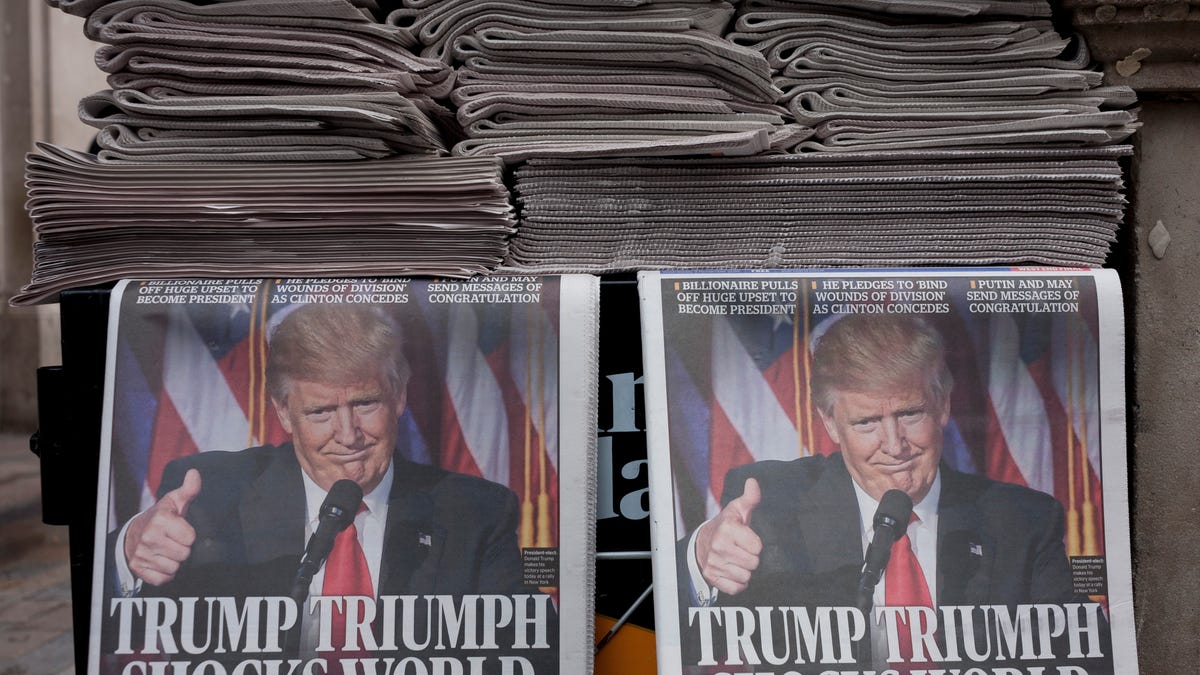Why social media couldn't call Trump's victory
Spredfast, a social media analysis firm, used its data to try to pick Trump or Clinton as president-elect. Here's what happened.

Chris Kerns is still asking himself what happened on Election Day.
Kerns, who runs research at social media analytics firm Spredfast, had a mountain of social media data at his disposal on Tuesday. But he was seeing so many conflicting signs in the presidential race between Republican Donald Trump and Democrat Hillary Clinton that he didn't feel comfortable giving the edge to either candidate.
"I wasn't confident calling anything," Kerns said. "It was still too tight."
Before Trump's stunning victory, CNET News had asked the Austin, Texas-based Spredfast to see if its data could call which candidate would be the next commander-in-chief. Could social media fill the role that exit polls have traditionally played?
It proved tougher than expected.
Of course, Spredfast wasn't alone in struggling to predict the election. Numerous exit polls picked Clinton. They got it flat-out wrong.
Political pundits and analysts, many of whom had correctly predicted previous campaigns, were similarly stumped. They proved incapable of seeing a Trump triumph.
We'll likely spend months, if not years, trying to figure out what went wrong.
Spredfast data shows the social media leanings of presidential voters in Florida, a key swing state where Donald Trump eventually prevailed.
Kendall Tucker, the CEO of Polis, says part of the problem is that polling methods rely heavily on phones and the internet, both of which leave out large chunks of the population. Phone polling relies on landlines, which are falling in popularity, and online polls miss older voters, who aren't as tech-savvy as younger voters.
"As we saw last night, there was a wave of turnout among rural voters unlikely to be polled with these traditional methods, which is why even the most trusted projections were so far off," said Tucker, whose company makes software to aid door-to-door canvassing. "The most accurate contact and assessment of voters' leanings is done by door-to-door contact."
Perhaps that wave of Trump voters is choosing to be stealthy or to stay undecided because so many people dislike him. It's reminiscent of what happened to former Los Angeles Mayor Tom Bradley, who lost his 1982 bid for governor of California despite leading in many polls prior to Election Day. Many poll respondents said they were voting for him, but actually didn't. In political science circles this is now called the "Bradley effect."
Karen North, head professor of the social media master's program at the University of Southern California, says political polling is going through a "shocking introspection" and questions whether it is capturing all demographics.
She thinks social media, with its huge swath across age, race, gender and socioeconomic status, better predicts voter behavior because people share their choices with the public.
"Can social media solve it? Who knows exactly, but it's a way to find people you couldn't otherwise in more traditional ways," she said.
A surge in tweets for Trump
Spredfast thought it could track how Twitter users felt about the candidates in seven swing states. The firm vetted the accounts it used, ignoring those with fewer than 200 followers, which could be generating automatic tweets, and verified accounts belonging to known political figures, who would have ideological axes to grind.
Early on Election Day, pro-Clinton tweets were at a 3-to-1 margin. That suggested a possible Clinton blowout.
But then something happened.
By the evening, Trump had taken several key swing states, including Florida and Ohio. Tweets for the billionaire and former reality TV star began to spike and stayed strong throughout the night.
Kerns was cautious about calling a winner because voters were sending out a similar amount of positive tweets about both candidates. This has been the most unpredictable race in history, reflected in social's response until Clinton conceded Wednesday morning.
It also prompted Kerns to wonder if there was a silent group of Trump voters who didn't want to make their allegiance known on social media, at least not until the former reality TV star had won.
He calls them "leaners," people who won't give away their opinion in a group but might later lean in and whisper, "I'm thinking about voting for Trump."
Given the negative tone of the race, Kerns said, many voters likely chose to hide their support to avoid criticism.
"People have to be in a place where they feel comfortable or willing to self-declare," Kerns said. "In this election, they were not."
North says with Trump receiving so much backlash from his controversial comments about women, Muslims and Hispanics, his supporters didn't want to risk becoming "social pariahs."
Kerns said Spredfast's experiment was worthwhile, even if it yielded unsatisfying results. They hope to have new networks, more sources and more volume to see trends early. Social data, he adds, will become more important than polls in collecting voter reactions in the future.
"We have a ton of information from this wacky election we can learn from," he said.

